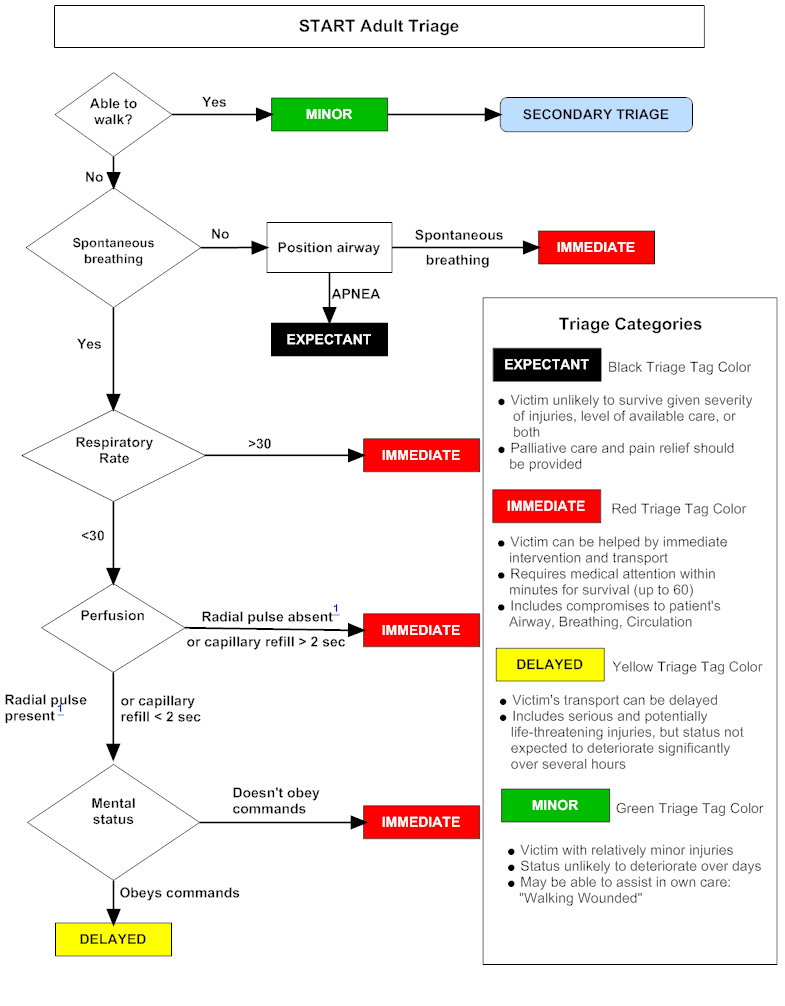You are here: Home > Triage Guidelines > START Adult Triage Algorithm
START Adult Triage Algorithm
 View/Print as PDF
(PDF - 98 KB)
Text Version
View/Print as PDF
(PDF - 98 KB)
Text Version D
D
Adapted from START Triage
Background information
- START was developed by the Newport Beach Fire and Marine Department and Hoag Hospital in Newport Beach, California in 1983. 2
- Initially it used the ability to obey commands, respiratory rate, and capillary refill to assign triage category.
- Modifications to START in 1996 by Benson et. al. substituted radial pulse for capillary refill, with a report of improved accuracy, especially in cold temperature. 1
- The Benson revision (START - SAVE [Secondary Assessment of Victim Endpoint]), also incorporates additional factors that determine "survivability" over time as the event progresses and assumes limited response resources. 1
- There has been limited rigorous scientific review of various forms of mass casualty incident triage used around the world. 1,4-6
- New methods of triage using new algorithms have been proposed, but not tested in the field 5,6
- At present START remains the most commonly used mass casualty triage algorithm in the US.
References
- Benson M, Koenig KL, Schultz CH. Disaster triage: START, then SAVE-a new method of dynamic triage for victims of a catastrophic earthquake. Prehospital Disaster Med. 1996; Apr-Jun; 11(2): 117-24 [PubMed Citation]
- START Support Services (Newport Beach, CA Fire Department, Commercial site, no endorsement implied)
- Alternative version of START algorithm (Critical Illness & Trauma Foundation, Inc., 2001)
- Garner A, Lee A, Harrison K, Schultz CH. Comparative analysis of multiple-casualty incident triage algorithms. Ann Emerg Med, 2001;38:541-548. [PubMed Citation]
- Jenkins JL, McCarthy ML, Sauer LM, et al. Mass-casualty triage: time for an evidence-based approach. Prehosp Disaster Med, 2008;23:3-8 [PubMed Citation]
- Cone DC, Koenig KL. Mass casualty triage in the chemical, biological, radiological, or nuclear environment. Eur J Emerg Med 2005; 12:287-302 [PubMed Citation]
- Sacco WJ, Navin DM, Fiedler KE, et al. Precise Formulation and Evidence-based application of resource-constrained triage. Acad Emerg Med 2005, 12(8):759-770 [PubMed Citation]
- Cone DC, MacMillan DS. Mass-casualty triage systems: A hint of Science. Acad Emerg Med 2005, 12(8): 739-741 [PubMed Citation]
- Lerner EB, Schwartz RB, Coule PL, et al., Mass casualty triage: An evaluation of the data and development of a proposed national guideline. Disaster Med and Public Health Preparedness, 2008;2(Suppl 1):S25-S34. [PubMed Citation]
- SALT Mass Casualty triage: concept endorsed by the American College of Emergency Physicians, American College of Surgeons Committee on Trauma, American Trauma Society, National Association of EMS Physicians, National Disaster Life Support Education Consortium, and State and Territorial Injury Prevention Directors Association. Disaster Med and Public Health Preparedness, 2008;2(4)245-246. [PubMed Citation]
PDF documents can be viewed with the free Adobe® Reader™
